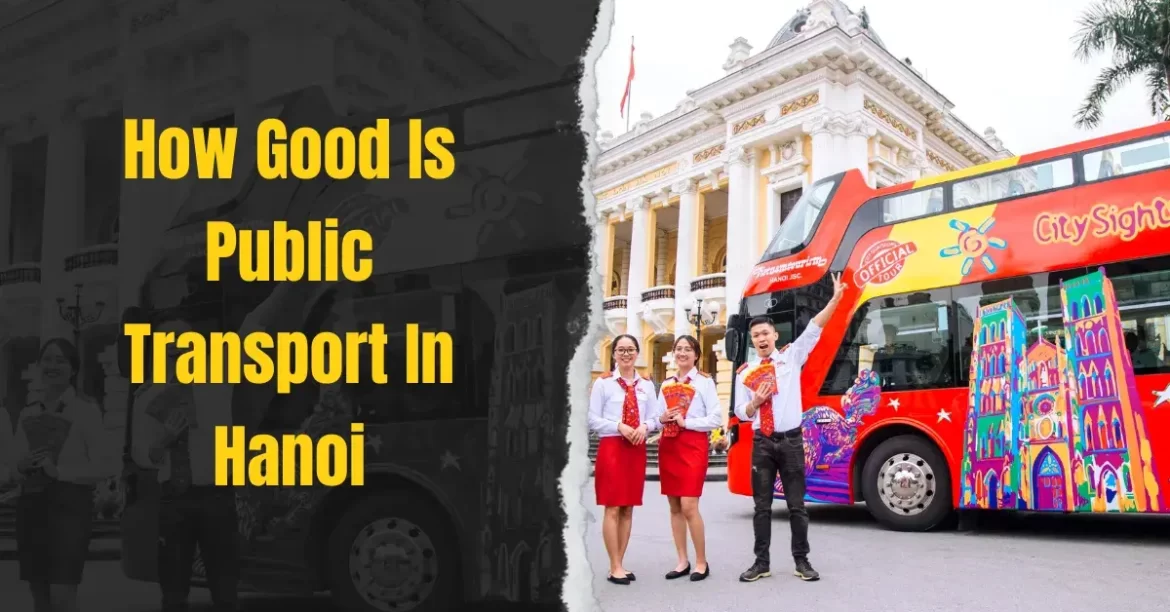A Comprehensive Guide To Public Transport In Hanoi, Vietnam
As the bustling capital city of Vietnam, Hanoi is a vibrant destination with a rich cultural history and beautiful landscapes. One of the best ways to explore the city is through its extensive public transport system, which includes local buses, taxis, trains and bikes.
So let’s take a deep dive into the different modes of public transport available in Hanoi, focusing on prices, safety and other essential information to help make your trip a smooth and enjoyable experience.
Local Buses Around Hanoi
Hanoi’s bus system, operated by the Hanoi Transport Corporation (Transerco), is an affordable and efficient way to navigate the city. With over 100 routes and thousands of stops throughout the city, buses in Hanoi are a popular choice for both locals and tourists.
Prices: Bus fares in Hanoi are quite affordable, with a single journey ticket costing between 5,000 VND (0.22 USD) and 9,000 VND (0.39 USD) depending on the distance. You can also purchase a monthly pass for unlimited travel on all Transerco buses for 200,000 VND (8.70 USD).
Safety: Buses in Hanoi are generally considered safe for travelers, but it’s always a good idea to keep an eye on your belongings and avoid displaying valuables. During peak hours, buses can get crowded, so be prepared for close quarters.
Tips: To find your way around the city, use apps like Google Maps or Moovit, which can help you plan your route and provide real-time updates on bus schedules. Also, try to have small change available for your bus fare, as drivers may not always have change for larger bills.
Taxis In Hanoi
Taxis are a convenient and comfortable way to travel around Hanoi and with numerous taxi companies operating in the city, it’s easy to find a cab whenever you need one.
Prices: Taxi fares in Hanoi vary by company, but generally start at 10,000 VND (0.44 USD) for the first kilometer and increase by around 6,000 VND (0.26 USD) per kilometer thereafter. It’s important to note that some taxis may have a higher starting rate during peak hours or at night.
Safety: Reputable taxi companies in Hanoi include Mai Linh, Taxi Group, and Vinasun. These companies use meters to calculate fares and are generally considered safer and more reliable than unmarked cabs. To ensure your safety, always choose a reputable taxi company and avoid getting into unmarked vehicles.
Tips: To avoid communication difficulties, have your destination address written down in Vietnamese or use a map to show the driver where you would like to go. You can also download taxi-hailing apps like Grab or Gojek to book a ride, which can be especially useful if you have limited local language skills.
Trains In And Around Hanoi
Hanoi serves as an important railway hub in Vietnam, connecting the city to other major destinations across the country. The primary railway station, Hanoi Railway Station, is located in the city center and offers both domestic and international services.
Prices: Train fares depend on the destination, class, and type of train. For example, a one-way ticket from Hanoi to Ho Chi Minh City on a soft-sleeper berth in an air-conditioned cabin ranges from 900,000 VND (39 USD) to 1,200,000 VND (52 USD).
Safety: Trains in Vietnam are generally considered safe, but it’s important to keep an eye on your belongings and choose a secure compartment if possible. Additionally, be cautious when navigating the platforms, as they can be crowded and chaotic.
Tips: Booking train tickets in advance is highly recommended, especially during peak travel seasons like holidays or festivals and you can purchase tickets at the railway station, through a travel agency, or online via the Vietnam Railways website or other reputable booking platforms. Be sure to arrive at the station at least 30 minutes before departure to allow enough time for boarding and potential security checks.
Bikes And Bicycles In Hanoi
Cycling and motorbikes are popular modes of transportation in Hanoi, offering a flexible and convenient way to explore the city. Whether you choose a traditional bicycle or a motorbike, navigating the streets of Hanoi on two wheels can be an exhilarating experience.
Prices: Bicycle rental rates in Hanoi range from 30,000 VND (1.30 USD) to 50,000 VND (2.17 USD) per day, while motorbike rentals typically cost between 120,000 VND (5.22 USD) and 200,000 VND (8.70 USD) per day. Rental prices may vary depending on the type and quality of the bike, as well as the rental duration.
Safety: Traffic in Hanoi can be chaotic and challenging to navigate, so it’s essential to exercise caution and follow local traffic rules when cycling or riding a motorbike. Make sure to wear a helmet, and if you’re new to motorbikes, consider taking a short training course before hitting the road.
Tips: When renting a bike, inspect it thoroughly for any damages or issues before taking it out. Also, ask the rental agency for a lock to secure the bike when parked. Keep in mind that during rush hour, it may be difficult to find parking spaces for motorbikes near popular tourist attractions, so plan accordingly.
Conclusion
Hanoi’s public transport system offers a variety of options for travelers, each with its own advantages and challenges. Whether you choose to navigate the city by bus, taxi, train or bike, understanding the local transport landscape and being prepared with essential information, will help you make the most of your time in this vibrant city.
If you always prioritize safety, be mindful of your surroundings and embrace the adventure of exploring Hanoi’s bustling streets and hidden gems, you’ll have a time to remember.

